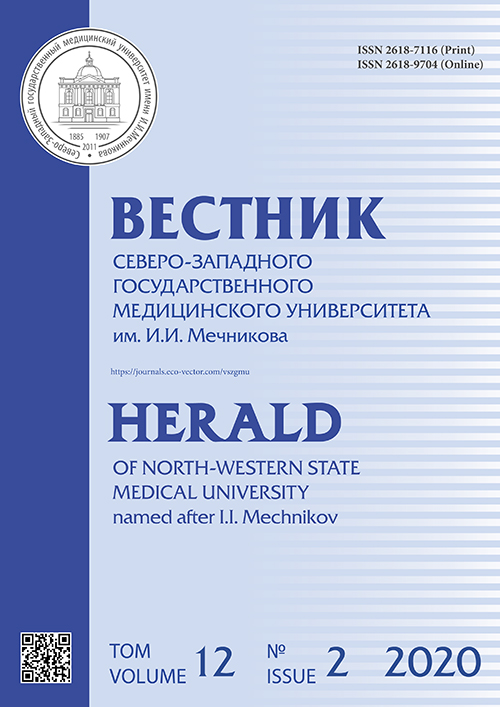椎动脉损伤的外科治疗经验
- 作者: Glushkov N.I.1, Rylkov V.F.2, Sementsov K.V.1, Skorodumov A.V.1, Moiseev A.A.3, Alekseev V.V.1, Koshelev T.E.1, Votinova A.O.1
-
隶属关系:
- North-West State Medical University named after I.I. Mechnikov
- City Hospital No. 26
- First Saint Petersburg State Medical University named after Academician I.P. Pavlov
- 期: 卷 12, 编号 2 (2020)
- 页面: 45-50
- 栏目: Original study article
- ##submission.dateSubmitted##: 16.04.2020
- ##submission.dateAccepted##: 28.04.2020
- ##submission.datePublished##: 21.08.2020
- URL: https://journals.eco-vector.com/vszgmu/article/view/33761
- DOI: https://doi.org/10.17816/mechnikov202012245-50
- ID: 33761
如何引用文章
详细
本研究的目的是分析脊髓动脉损伤患者的治疗结果。
材料与方法。两年来,对7例椎动脉损伤患者的治疗进行了分析,这些患者住进了City Hospital №26 — St.Petersburg。诊断和治疗这些损伤的问题是确定的。提出了解决这些问题的方法。本文报告两例成功治疗椎动脉损伤的临床病例。
结果。如果颈部受伤,则有椎动脉损伤的可能。因此,在急诊手术中使用高信息的检查方法(血管造影螺旋CT、磁共振成像)和微创(x射线血管内)是必要的。进行复杂仪器检查的决定应由外科医生做出,外科医生还应考虑相关专家的建议,决定检查的性质、范围和紧迫性。
结论。无论伤口大小和颈部受伤受害者的状况如何,都应在大型医院进行检查和治疗,在那里值班小组包括血管外科医生和其他专科医生,在紧急情况下有机会进行全天24小时的全面检查和实施高科技外科干预。
全文:
绪论
现代急诊手术中最困难和最紧迫的问题之一是颈部受伤患者的治疗。在战时,颈部受伤的比例达到总数的1.5—2%。
在4.6—9%的病例中,颈部损伤伴有大血管损伤[1-4]。颈部主要血管受伤的受伤者中,高达95%的人在受伤现场和运输过程中死亡[3, 5, 6]。大部分这些患者由救护车送到最近的值班外科医院,在大多数情况下,其值班中没有血管外科医生。在汇总统计中,该地区伤口诊断错误的
频率,即使在专科外科医院,也在7—38%之间[7-9]。在这种情况下,手术治疗后的死亡率达到14—40%[3, 10, 11]。另一组由椎动脉损伤的患者组成。动脉地形图的特点决定了手术的困难,少量外部出血,同时对颈部其他结构的损害,使诊断和治疗这些损伤的结果不令人满意。
本研究的目的是分析脊髓动脉损伤患者的治疗结果。
材料与方法
两年来,对7例椎动脉损伤患者的治疗进行了分析,这些患者住进了City Hospital №26 — St.Petersburg。受害
者年龄从18岁到56岁不等,其中5人是
男性。3名受害者被收治时情况极其严重,
并受了复合伤,其中2名伤势严重,2名伤
势中等。在3个病例中,椎动脉被诊断为闭合性损伤,2名受害者颈部有枪伤,
1名有刺伤,还有1名颈部有割伤。2名损害是由交通事故造成的,1名损害是由从高处坠落时发生的损伤,另外2名受害者受了枪伤,1名与工伤和自杀有关。在5例患者中,椎动脉损伤伴有颈椎骨折,其中
3例患者报告了与生活不相符的损伤。
椎动脉损伤更多的是在椎动脉II节段被检测到—4例患者,2例患者出现椎动脉I节段出现损伤,1例椎动脉III节段出现损伤。
病情严重,时间紧迫,需要紧急止血和换血,这些都是外科医生面对椎动脉损伤颈部损伤的极其困难的任务。
在重症监护病房和手术台上进行诊断,继续进行强化的术前准备工作,包括将患者从休克状态中移除,补充失血。除了外科医生和麻醉师外,受害者还根据临床表现接受相关专家的检查。咨询神经科医生或神经外科医生一直是检查昏迷病人的重要组成部分。胸部x线检查和心电图检查是强制性的。在血液图的基础上,决定了红细胞输血的权宜之计。对于非关键参数(血红蛋白—80-90 g/L,红细胞压积—约30%),术中用晶体和胶体矫正低血容量。颈部伤口用手指压迫受损血管暂时止血,狭窄长创口用福格蒂探针或弗利球囊导管压迫止血。
在第二阶段,对颈部开放性伤口的受害者进行伤口检查。更常见的是,采用了沿点头肌前缘的典型投影入路(根据V.I. Razumovsky的结肠切开术),这提供了手术视野的最佳视图以及通过穿过锁骨扩大手术视野的可能性,或者,如果必要的话,部分胸骨切开术。
椎动脉在I和III节段损伤时,对血管壁缺损进行缝合或包扎。当椎动脉在II节段受损时,分两个阶段进行最终止血。
由于这段动脉位于骨通道内,因此有必要暂时止血,随后打开通道壁,翻修受损的动脉段。最终止血的最后阶段很大程度上取决于手术医生的经验、血液
动力学状态和渐进性侵犯重要功能
的存在。
止血的第一阶段有多种选择。在1例病例中,球囊导管通过动脉的第一段插入
(图1)。实现了暂时止血,这允许打开椎动脉通道,恢复动脉的完整性或在Lexer试验后结扎它。椎动脉I段结扎和用蜡和止血海绵复合材料填充椎动脉II段骨缺损是目前广泛使用的方法。还有一种技术是在远端和近端方向插入Fogarty 3号探针来临时止血。然而,在本研究中,我们使用了一种更简单,但同样有效的原始的临时止血方法。使用粗钳压迫损伤部位上下肋间韧带,可快速显著减少出血,从而打开骨通道,进行最终止血。
图 1 椎动脉球囊阻塞II节段损伤:1 — 球囊导管; 2 — 动脉损伤区域;3 — 导管;4 — 动脉结扎区; 5 — 锁骨下动脉[12]
在主要血管和空腔或实质脏器合并损伤的情况下,在手术血管阶段结束后对其进行干预。所有患者术后均给予抗凝治疗,无例外。肝素以每6小时250-300 U / kg的剂量给药6-8天。为评估可靠止血后的脑循环充分性,所有患者均行经颅多普勒显像术。
结果
在本节中,我们提出两个颈部损伤的
观察,清楚地显示出椎动脉损伤的诊断和止血选择的复杂性。
M.患者,34岁,因交通事故入城市的急诊医院26号,诊断为:闭合性颅脑外伤,
中度脑挫伤,颈裂伤,胸部挫伤,闭合性
腹部损伤,右胫骨开放性骨折,三级休克。
患者在极其严重的情况下被转到救护室。
体检显示了:意识恍惚改变,血压未
检出。临床血检:白细胞—12.5 ∙ 109/L,
红细胞—2.01 ∙ 1012/L,血红蛋白—
68 g/L。凝血时间图:凝血酶原—74%,
纤维蛋白原—1890 mg/L,国际标准化比值—1.2。血液生化分析:血糖—
15.2 ml/L,丙氨酸氨基转移酶—
235 ED/L,淀粉酶—69.8,天冬氨酸氨基转移酶—325.4 ED/L,肌酐—82.6。心电
图上窦性心动过速—120次/分,弥漫性
改变,复极化失调。左侧颈部发现一个开放性伤口,有大量出血。
患者被转移到紧急手术室,在进行抗休克治疗的背景下复查颈部伤口。伤口有
9.0 cm长,呈三角形,内部成开放的
角度。在第I段发现颈内静脉与左椎动脉完全相交(图2)。
图 2 左侧椎动脉与I段完全相交,椎动脉末端离断4.0 cm
动脉远端和近端节段之间的距离约为4 cm。甲状腺下静脉破裂和第七颈椎横突粉碎性骨折伴远端移位,颈部左侧
I-III肋骨骨折,胸锁乳突肌压碎,臂丛根部完全损伤。从第VII椎横突碎片中取出异物(面积约为1平方厘米的三角形
玻璃)。最后结扎受损动脉(Lexer试验
阳性)止血。手术通过恢复点头肌和引流伤口而完成。住院第19天,患者出院
接受门诊治疗,并建议随后在神经外
科住院。
特别值得关注的是在受骨通道保护的椎动脉II段受损时的止血问题。由于邻近颈丛神经根,这一区域的止血也受
到阻碍。
B.患者,48岁,被送往城市的急诊医院26号诊断:右侧面部切口并过渡到颈部前外侧表面。在锁匠工作时,铣刀的碎片击中了伤口(图3)。
图 3 颈部右侧切口伤口
本例中,止血是由异物引起—磨盘的碎片,其穿过了C5—C6椎体横突之间的
结构,紧紧地卡在C5椎体中。当异物被取出时,伤口通道出现大出血。临时止血是通过一种原始的方法实现的,即通过肋间韧带的刚性分支压迫右椎动脉第二节。
翻修显示右侧椎动脉在II节完全创伤
相交,口咽、食管上三分之一、C5椎体和C5—C6神经根受损。椎动脉第I段结
扎后,将第II段动脉通道部分打开
(图4),用蜡和止血海绵复合材料填充骨缺损。
图 4 右椎动脉部分疏通管
术后无明显变化。患者因右颈丛轻度神经功能缺损而出院接受门诊治疗。
讨论
颈部大血管受损时,几乎不会出现大的裂口创面,创面渠道狭窄较为常见,否则这样的创面因失血过多而与生命不相容。在有
利的情况下,即使颈动脉或颈静脉等大血管受到损伤,出血也能自行停止。当血液通过血管壁的创口流入阴道血管时,就会形成微血管旁血肿,压迫血管,从而帮助止血。
在这种情况下,即使计算机断层扫描检查也不能排除主要血管的损伤,这就需要快速修复伤口。同时,一方面,手术通路应该是经济的,对颈部结构的损害最小,另一方面—足以对动脉进行全面翻修,必要时,在大出血的情况下进行止血。
这些例子再次表明,全面诊断和治疗颈部损伤患者的困难。然而,只有使用现代研究方法的可能性,如螺旋计算机断层
扫描,多普勒显像,医生团队里血管外科的存在和积极的外科战术,使能够向这些患者提供及时、全面、合格的援助。
结论
椎动脉损伤由于地形解剖特点、通道
深度、大出血及颈部周围内部结构损伤频繁等原因,较难诊断和治疗。由于颈部损伤有可能损伤椎动脉,急诊手术应采用高信息的检查方法(螺旋CT血管造影、磁共振成像)和微创手术(x射线血管内)。
进行复杂仪器检查的决定应由外科医生
做出,外科医生还应考虑相关专家的
建议,决定检查的性质、范围和紧迫性。
结论
无论伤口大小和颈部受伤受害者的状况
如何,都应在大型医院进行检查和治疗,
在那里值班小组包括血管外科医生和其他专科医生,在紧急情况下有机会进行全天
24小时的全面检查和实施高科技外科干预。特殊的困难是由于受骨保护的动脉II段受损
造成的。
作者简介
Nikolay Glushkov
North-West State Medical University named after I.I. Mechnikov
编辑信件的主要联系方式.
Email: nikolay.glushkov@szgmu.ru
ORCID iD: 0000-0001-8146-4728
Doctor of Medicine Science, Professor, head of the Department of General surgery
俄罗斯联邦, Saint-PetersburgVladimir Rylkov
City Hospital No. 26
Email: v_rylkov@mail.ru
surgeon St. Petersburg City Public Healthcare Institution "City Hospital No. 26"
俄罗斯联邦, Saint-PetersburgKonstantin Sementsov
North-West State Medical University named after I.I. Mechnikov
Email: konstantinsementsov@gmail.ru
assistant professor of the Department of General surgery of the North-Western state medical University. I. I. Mechnikov
俄罗斯联邦, Saint-PetersburgAnatoliy Skorodumov
North-West State Medical University named after I.I. Mechnikov
Email: askorodum@mail.ru
assistant professor of the Department of General surgery of the North-Western state medical University. I. I. Mechnikov
俄罗斯联邦, Saint-PetersburgAlexey Moiseev
First Saint Petersburg State Medical University named after Academician I.P. Pavlov
Email: moiseev85@mail.ru
Assistant Professor of Hospital surgery of the Pavlov First Saint Petersburg State Medical University
俄罗斯联邦, Saint-PetersburgValentin Alekseev
North-West State Medical University named after I.I. Mechnikov
Email: valentindocvma@mail.ru
Assistant of the Department of the Department of General surgery of the North-Western state medical University. I. I. Mechnikov
俄罗斯联邦, Saint-PetersburgTaras Koshelev
North-West State Medical University named after I.I. Mechnikov
Email: kte@yandex.ru
assistant professor of the Department of General surgery of the North-Western state medical University. I. I. Mechnikov
俄罗斯联邦, Saint-PetersburgAnastasia Votinova
North-West State Medical University named after I.I. Mechnikov
Email: votinova.anastasya@gmail.com
student of the medical faculty of the North-Western state medical University. I. I. Mechnikov
俄罗斯联邦, Saint-Petersburg参考
- Орлов В.П. Лечение огнестрельных ранений черепа и позвоночника в условиях локальных войн и военных конфликтов. – СПб.: ВМедА, 2003. – 35 с. [Orlov VP. Lechenie ognestrel’nykh raneniy cherepa i pozvonochnika v usloviyakh lokal’nykh voyn i voennykh konfliktov. Saint Petersburg: VMedA; 2003. 35 p. (In Russ.)]
- Гофман В.Р. Результаты лечения ранений ЛОР-органов // Военно-медицинский журнал. – 1992. – Т. 313. – № 6. – С. 21–24. [Gofman VR. Rezul’taty lecheniya raneniy LOR-organov. Voen Med Zh. 1992;313(6):21-24. (In Russ.)]
- Бисенков Л.Н., Ляшенко В.Г. Успешное лечение ранений общей сонной артерии // Вестник хирургии им. И.И. Грекова. – 1982. – Т. 129. – № 7. – С. 97–98. [Bisenkov LN, Lyashenko VG. Uspeshnoe lechenie raneniy obshchey sonnoy arterii. Vestn Khir Im I I Grek. 1982;129(7):97-98. (In Russ.)]
- Белевитин А.Б., Шелепов А.М., Ишутин О.С., Леоник С.И. Организация оказания медицинской помощи и лечения легкораненых и легкобольных в военном полевом эвакуационном госпитале // Вестник Российской военно-медицинской академии. – 2011. – № 1. – С. 232–240. [Belevitin AB, Shelepov АМ, Ishutin OS, Leonik SI. Organisation of medical care and treatment of slightly wounded and slightly sick in a field evacuation military hospital. Vestnik Rossiiskoi voenno-meditsinskoi akademii. 2011;(1):232-240. (In Russ.)]
- Белевитин А.Б., Синопальников И.В. Организация розыска, сбора, выноса (вывоза) с поля боя и эвакуации раненых из районов боевых действий в вооруженных конфликтах // Вестник Российской военно-медицинский академии. – 2010. – № 4. – С. 177–179. [Belevitin AB, Sinopal’nikov IV. The organization search, gathering, and medical evacuations ingured from battle-ground armed conflict. Vestnik Rossiiskoi voenno-meditsinskoi akademii. 2010;(4):177-179. (In Russ.)]
- Каншин, Н.Н., Воленко А.В., Николаев А.В. Аспирационные методы профилактики нагноения-послеоперационных ран: методические рекомендации. – М., 1985. – 14 с. [Kanshin NN, Volenko AV, Nikolaev AV. Aspiratsionnye metody profilaktiki nagnoeniya posleoperatsionnykh ran. Metodicheskie rekomendatsii. Moscow; 1985. P. 14. (In Russ.)]
- Дуданов, И.П., Ижиков Ю.А, Мячин Ю.А. Лечение ранений с повреждением сосудов шеи // Актуальные проблемы современной тяжелой травмы: материалы всероссийской научной конференции. – СПб., 2001. – С. 40–41. [Dudanov IP, Izhikov YA, Myachin YA. Lechenie raneniy s povrezhdeniem sosudov shei. In: Aktual’nye problemy sovremennoy tya-zheloy travmy: Materialy vserossiyskoy nauchnoy konferentsii. Saint Petersburg; 2001. P. 40-41. (In Russ.)]
- Fogelman MJ, Stewart RD. Penetrating wounds of the neck. Am J Surg. 1956;91(4):581-593. https://doi.org/ 10.1016/0002-9610(56)90289-6.
- Fry WR, Dort JA, Smith RS, et al. Duplex scanning replaces arteriography and operative exploration in the diagnosis of potential cervical vascular injury. Am J Surg. 1994;168(6):693-696. https://doi.org/10.1016/s0002-9610 (05)80147-3.
- Landreneau RJ, Weigelt JI, Magison SM, et al. Combined carotid-vertebral arterial trauma. Arch Surg. 1992;127(3):301-304. https://doi.org/10.1001/archsurg. 1992.01420030067012.
- Lourencao JL, Nahas SC, Margarido NF, et al. Penetrating trauma of the neck: prospective study of 53 cases. Rev Hosp Clin Fac Med Sao Paulo. 1998;53(5):234-241.
- Kaiser LR, Pearce WH. ACS Surgery: Principles & Practice. 7th ed. WebMD Professional Pub.; 2007.
补充文件










